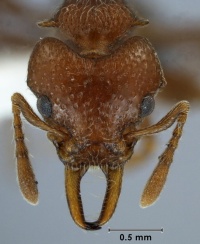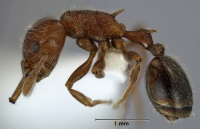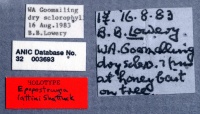Epopostruma lattini
| Epopostruma lattini | |
|---|---|

| |
| Scientific classification | |
| Kingdom: | Animalia |
| Phylum: | Arthropoda |
| Class: | Insecta |
| Order: | Hymenoptera |
| Family: | Formicidae |
| Subfamily: | Myrmicinae |
| Tribe: | Attini |
| Genus: | Epopostruma |
| Species: | E. lattini |
| Binomial name | |
| Epopostruma lattini Shattuck, 2000 | |
Epopostruma lattini is known from two disjunct populations, one in southern Western Australia and the other in southern South Australia. It has been found at honey baits on trees in the evening and in leaf litter, in dry sclerophyll and mallee habitats.
Identification
This large, distinctive ant can be recognised by the distinctive head shape, the bispinose lateral postpetiolar margins, by having the area immediately above the eye angular but no toothed and in having the posterolateral margin of the postpetiole (immediately anterior of the gaster) strongly concave.
Keys including this Species
Distribution
Latitudinal Distribution Pattern
Latitudinal Range: -30.18333333° to -34.23333333°.
| North Temperate |
North Subtropical |
Tropical | South Subtropical |
South Temperate |
- Source: AntMaps
Distribution based on Regional Taxon Lists
Australasian Region: Australia (type locality).
Distribution based on AntMaps
Distribution based on AntWeb specimens
Check data from AntWeb
Countries Occupied
| Number of countries occupied by this species based on AntWiki Regional Taxon Lists. In general, fewer countries occupied indicates a narrower range, while more countries indicates a more widespread species. |

|
Estimated Abundance
| Relative abundance based on number of AntMaps records per species (this species within the purple bar). Fewer records (to the left) indicates a less abundant/encountered species while more records (to the right) indicates more abundant/encountered species. |

|
Biology
Castes
Nomenclature
The following information is derived from Barry Bolton's Online Catalogue of the Ants of the World.
- lattini. Epopostruma lattini Shattuck, in Bolton, 2000: 60 (w.) AUSTRALIA.
Type Material
- Holotype, worker, Goomalling, Western Australia, Australia, Lowery,B.B., ANIC32-003693, Australian National Insect Collection.
Unless otherwise noted the text for the remainder of this section is reported from the publication that includes the original description.
Description
Holotype worker. TL 5.2mm, HL 1.24mm, HW 1.28mm, CI 103, MandL 0.59mm, MandI 48, SL 0.71mm, SI 55, PronW 0.72mm, ML 1.27mm.
Area immediately above the eye angular. Pronotal spines present, long. Posterior section of metanotum and dorsal surface of the propodeum forming a continuous surface. Posterior face of propodeum between bases of spines and propodeal lobes with very narrow flanges with start below the bases of the spines. Petiolar spines present, long. Anterior face of postpetiole similar in length to or shorter than the dorsal face, the two faces joined by a broad convexity; sides of postpetiole expanded laterally in the form of distinct sharp teeth or spines; their lateral margins strongly concave; posterolateral margin (immediately anterior of gaster) strongly concave. Dorsum of petiole, postpetiole and gaster with numerous long, erect hairs, those on the mesosoma with strongly bent tips, those on petiole, postpetiole and gaster either straight or weakly arched. First gastral tergite and area immediately behind attachment with gaster smooth. Body colour dark yellow-red, ventral region of head, antennae, mandibles and legs lighter, gaster darker, brown.
References
- Heterick, B. E. 2009. A guide to the ants of South-western Australia. Records of the Western Australian Museum, Supplement 76:1-206.
- Heterick, B.E. 2021. A guide to the ants of Western Australia. Part I: Systematics. Records of the Western Australian Museum, Supplement 86, 1-245 (doi:10.18195/issn.0313-122x.86.2021.001-245).
- Heterick, B.E. 2022. A guide to the ants of Western Australia. Part II: Distribution and biology. Records of the Western Australian Museum, supplement 86: 247-510 (doi:10.18195/issn.0313-122x.86.2022.247-510).
- Shattuck, S. O. 2000. Genus Colobostruma. Genus Mesostruma. Genus Epopostruma. Pp. 31-67 in: Bolton, B. The ant tribe Dacetini. Mem. Am. Entomol. Inst. 65: 1-1028 (page 60, worker described)
References based on Global Ant Biodiversity Informatics
- Heterick B. E. 2009. A guide to the ants of south-western Australia. Records of the Western Australian Museum Supplement 76: 1-206.


